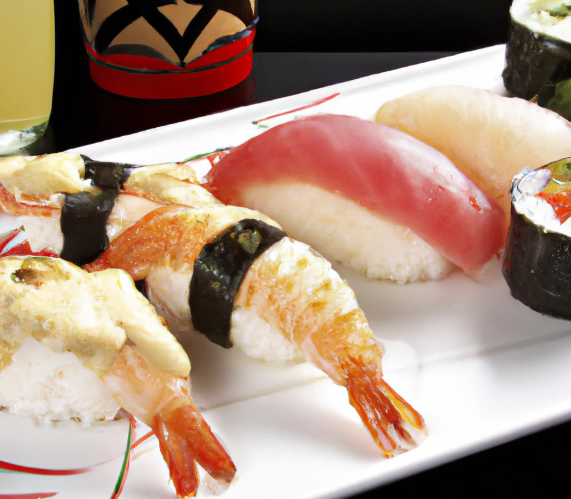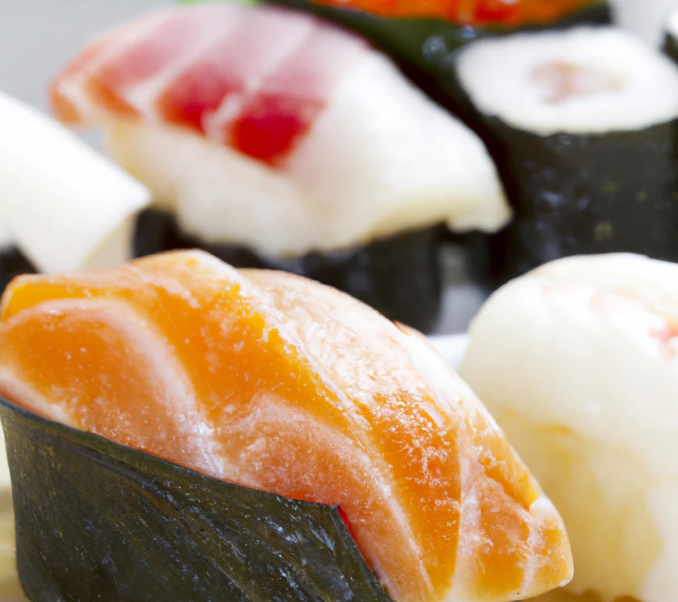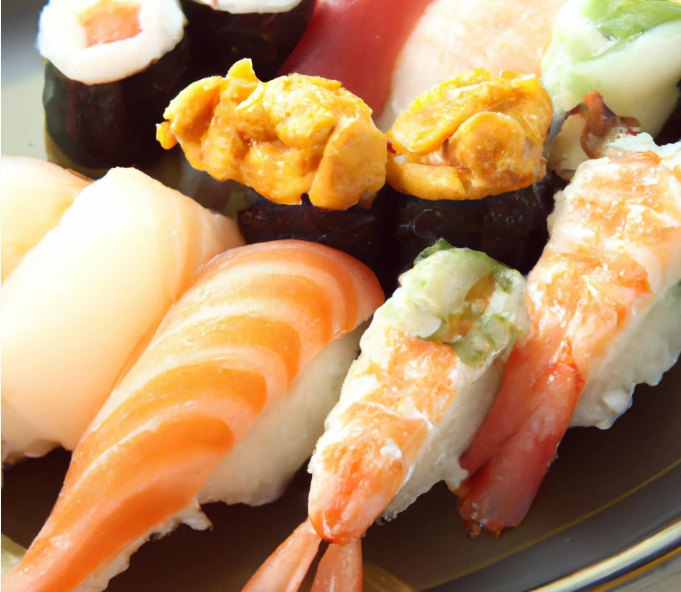If you’ve never had sushi, you might wonder what it tastes like. While the taste of sushi can vary depending on the type of fish and rice used, it generally has a light and delicate flavor. The texture of the rice is also essential, and it should be slightly sticky but not mushy. Overall, sushi is a refreshing and satisfying meal.
Contrary to popular belief, “sushi” does not refer to the raw fish commonly known for this dish. Instead, “sushi” refers to the vinegary seasoned rice used as a base. It makes sense when you consider how early versions of sushi—dating back hundreds of years—were made using only rice and seaweed. It was only later that fish was added to this traditional combination. Other ingredients, such as cucumber and avocado, are sometimes added to modern cuisine.
It may seem strange at first that one of the most recognizable dishes in Japanese culture isn’t named after its primary ingredient, but, in reality, it reflects the critical role that rice plays in sushi. Without its essential component, “sushi” wouldn’t exist – regardless of whether it’s topped with sliced fish! So, How would you describe the taste of sushi?
The art of making sushi has been around for centuries, but it was in 19th-century Japan that the traditional version of it gained popularity. And today, sushi is a staple in Japanese cuisine; many restaurants around the world feature the dish on their menus, and you can even buy prepackaged versions from grocery stores. The essential elements of sushi are simple: white rice mixed with vinegar and salt. This mixture forms the exterior wrap for the delicate ingredients inside and gives the sushi its distinct flavor. In addition, you can make sushi with various fillings–raw fish, seafood, vegetables, and even tofu.
Of course, if you’d like to get creative, you could also use other fruits and vegetables, such as mango or spinach. The possibilities are endless! Furthermore, one benefit to making your sushi is that you can control what goes into it–for example, if you want to make a lighter meal than traditional sushi allows, reduce the amount of rice used. All in all, regardless of how different types of sushi are presented or served in various places worldwide, anyone looking to enjoy some delicious traditional Japanese delicacies can find what they need by turning to classic sushi recipes.
Table of Contents
What To Expect When Eating Sushi For The First Time?
Eating sushi is usually a savoury, enjoyable experience, whether you want more authentic sashimi and nigiri or standard American sushi rolls. However, if you’ve never had much sushi in your life, you can be unsure of how to eat it properly and uncertain of what to do while eating it.
To begin with, there is no incorrect way to eat sushi. Don’t allow snobs make fun of you for choosing a California roll over a simple slice of grouper over rice or for dipping it in whichever sauce you like. The purpose of eating is to take pleasure in your food and consume it because it tastes good to you, not to please other people.
However, eating sushi can sometimes be a little perplexing. Would chopsticks be appropriate? Should I dunk my sushi in anything? If you like, may you use your hands? What roll should a newbie try first?
You have inquiries, and we have solutions. You’ve come to the right site if you’re interested in some of the most popular sushi eating techniques and sushi eating customs. Even sushi experts might not be aware of some of the fundamentals that we will cover here regarding how to eat sushi.
So if you’re ready to develop a sushi addiction and are unsure of where to begin, read on. We’ll cover all you need to know about sushi in our beginner’s guide, along with some advice that will help you get the most out of your first sushi experience.
The Sushi Eating Technique
Since every sushi business is unique, your configuration may alter slightly from the one we’ve outlined below. But every sushi chef is aware of a few “unwritten regulations” for sushi consumption.
You will receive a platter containing the rolls or sushi of your choice. Chopsticks and a bottle of soy sauce will also be placed on the table for you, and you might possibly get an extra plate for any snacks.

Although eating with your hands is fine, it is customary to eat sushi with chopsticks. Don’t worry about it if you don’t know how to use chopsticks or don’t feel comfortable using them because no one will judge you for using a fork instead.
You can probably order some “extras” or a combination meal with extras like egg rolls, miso soup, or a salad with ginger dressing if you go to a sushi restaurant for lunch or supper. The restaurant will determine this.
In terms of what’s on your plate, three items are often there:
- Your rolls of sushi
- a large dose of wasabi
- ginger pickles
The procedure of eating sushi will be covered in the following chapter of this guide, along with tips for enhancing the flavour of your meal.
The Method: Harmonizing Your Flavors
So why are wasabi and ginger served with sushi? Let’s talk about it and then go over how to eat sushi properly.
Wasabi is incredibly strong and spicy, but not in the same way that hot peppers are. It tastes a lot like horseradish. It has a burn and heat that clears the sinuses, but this passes quickly. Many people who want an extra kick mix some of their wasabi with soy sauce; however, we’ll get to that in a moment.
But the pickled ginger serves a different purpose. Pickled ginger has a very mild flavour and a calming aroma that can help you get beyond the horseradish’s heat while also wiping out the flavour of your previous sushi roll to get you ready for the following course.
Are you prepared to learn how to eat sushi the proper manner now? What you’ll do is as follows!
- Take your sushi dish from the chef or waitress.
- A little soy sauce should be placed in a bowl or on a plate.
- Sushi should be dipped into the soy sauce. Use your chopsticks to “brush” a little more wasabi onto the sushi if you want it to be even spicier.
- Take some sushi. Nigiri and sashimi, which are smaller portions, should be consumed in a single bite, whereas American-style rolls, which are larger, may require two or more bites.
- Chew the sushi thoroughly so that the flavour may fill your mouth.
- Take a sip of your sake if you’re having it with your sushi right now.
- Eat a slice of pickled ginger that is on your plate. You can do this between each bite or between each roll. This helps to cleanse your palate and get rid of the taste of your sushi roll.
- Continue until you are completely full or until the sushi is gone.
- I’m done now! The basic guidelines for eating sushi are as follows. Again, you are not required to abide by these guidelines if you choose not to. No one will look down on you if you eat sushi in your own way. Although they are traditional, these rules do help you maximise the flavour of your food. It’s fun to follow tradition, especially when consuming a cuisine with such a lengthy history as sushi!
Chopsticks vs. With Hands
The majority of individuals will use chopsticks to consume their sushi. In the West, this is the most popular technique because most people loathe eating with their hands. Chopsticks are also hygienic since they prevent you from spilling rice and raw fish on your plate, glass, and other items on the table.
However, it’s also a common practise to eat sushi with your hands, especially when it comes to classic meals like nigiri. Chopsticks are typically used to consume sashimi, but hands can also be used.
This again depends on your personal choices. And as we just said, there is nothing wrong with eating sushi with a fork. Sure, it’s not customary, but if that’s what you choose, no one will criticise you for it.
Standard Fish in Sushi
Sushi can be made with just about any type of fish. Salmon and tuna are popular choices, as well as crab, octopus, and shrimp. But you might also be able to find more uncommon items like sweetfish, swordfish, and eel—traditionally a favourite in Japan. Listed below are a handful of the typical fish varieties included in contemporary sushi rolls:
- Tuna
- Yellowtail
- Salmon \sShrimp
- Octopus \sCrab
- Seabass
- Mackerel
- Red marlin
- Swordfish
- Trout
- Eel \sAbalone
- Sweetfish
- Squid \sClams
- an Ark shell
- Scallop
- Sea bass
- Halfbeak
- Flatfish \sCockle
Simply ask your server what it is if you don’t recognise a type of seafood or an ingredient in a roll! Some of these substances may also be known by their Japanese names or by other names.
You can order a roll with a fish you know you enjoy, like salmon, tuna, or trout, to be on the safe side. Alternately, be a little more daring and try a type of fish you’ve never tried. The genuine raw flavour of the fish will come through quite strongly in sushi, making it possibly the finest way to explore a new variety of fish.
The Ideal Sushi for Novices
You’ll be eating sushi as a traditional roll unless you consume sashimi (or raw fish). Since nigiri just contains raw fish and rice, and sashimi simply consists of slices of raw fish, this is what we would advise for beginners. Rolls are easier to eat and frequently come with cooked contents.
The base of every sushi roll is the fish wrapped in seaweed and rice. However, clever sushi chefs produce scrumptious and distinctive rolls.
Do you feel uneasy eating raw fish? Search for anything that has “tempura” in it. In tempura, battered fish is lightly cooked. The fish is properly cooked, has a pleasant crunch, and gives every sushi roll to which it is put a great flavour.


